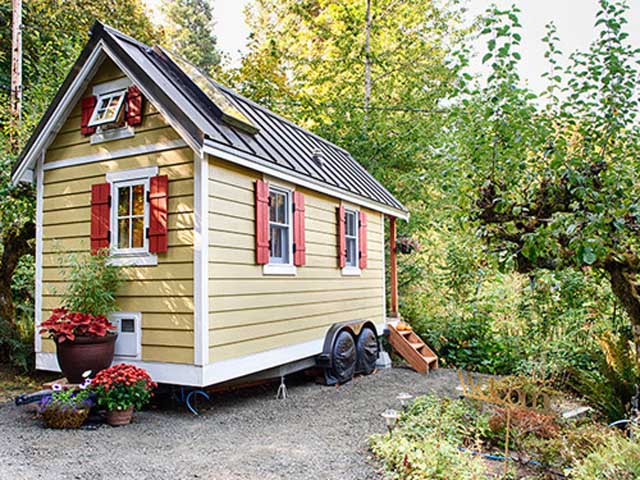Photo via CountryLiving.com
According to the Census Bureau, the average American home is about 2,600 square feet. While the national home size continues to rise, there is a growing population of Americans in favor of tiny houses. Reality TV shows including Tiny House Hunting, Tiny House Building, Tiny House Nation and Tiny House, Big Living have brought national attention to the movement. A typical tiny house falls between 100 and 400 square feet. The tiny house movement is one possible solution for individual, financial and environmental concerns. Most tiny homeowners also cite a simpler lifestyle as a main factor for choosing to “live tiny.”
One of the greatest benefits of living in a tiny house is the relatively low cost. The average tiny house costs around $50,000, but can cost significantly more or less depending on building materials used, location and luxuries included. Forbes estimates the cost at $200 to $400 per square foot. This makes tiny houses a great option for people who cannot afford a down payment on a larger home, but want to put their money toward owning something rather than paying rent.
Do-it-yourself homebuilders accumulate expenses over time throughout the building process rather than all at once, which works well as long as you have somewhere else to live in the meantime. Tiny houses are often seen as a way to pay off loans or live debt free with the opportunity to spend less time working.
Prefabricated homes can be purchased at nearly every stage of the building process from an empty shell to a decorated home. There are companies that will work to customize a tiny home. However, the handcrafted trend has always been central to the goals of the tiny house movement. Homeowners can build their houses to their exact needs and specifications.
Doing it yourself also allows you to save money while reducing your environmental impact by using reclaimed materials. Labor costs are also avoided. One tiny house blog estimates that it takes about 120 hours for a professional to build a tiny house, and about 480 hours for someone with minimal construction experience (which may take as little as three months or up to several years).
Living in a tiny house is also a great way to reduce environmental impacts. A tiny house requires less heating, cooling and electricity. It also requires that you own fewer material possessions. It is also easier to run your home completely off the grid. Solar panels are a popular source of renewable energy for tiny houses. Tiny houses often include composting toilets to save water (and eliminate blackwater systems) and can be heated by compact wood stoves.
Living in a tiny house is a completely different lifestyle than most Americans are used to. There are both advantages and drawbacks, which make tiny houses more suitable for some people than others. One advantage is having less to clean and maintain. Well-designed tiny homes make an efficient use of space that is ideal for its specific occupants and their needs. For this reason, it is possible for families to live in a tiny house. Even families with multiple children and/or pets can make tiny house living work by putting some effort into the logistics. Although it can certainly be tricky living with multiple people in such close quarters, the experience reportedly fosters a better sense of connection.
A tiny house on wheels (THOW) is ideal for those who love to travel, have a sense of adventure or recent graduates who do not want to be tied to a particular location. Tiny houses are not ideal for people who like to throw dinner parties or host multiple guests overnight. They’re also not the best idea for those who have a great deal of belongings that they are not willing to part with.
The demographics of tiny house owners are scattered all across the board. They include all genders, individuals, couples, families, recent college graduates, young entrepreneurs, middle-aged professionals and retirees. Tiny houses can be found across the country and in many other countries around the world.
Unfortunately for those enthused about living in a tiny house, they often fall into a legal gray area or are simply not legal. Many states or towns have restrictions on the minimum size of what can be considered a permanent home. Tiny houses can be built on several different types of temporary or semi-permanent foundations. If it is considered temporary, there are limits to how long it can be occupied. If it is on a piece of property with an existing full size house, a tiny home may be considered an Accessory Dwelling Unit, which is legal.
Another way to avoid illegal living is to build the house on a trailer and get it certified as a Recreational Vehicle. Unfortunately, this certification can be difficult and expensive to obtain. Town zoning laws can also prohibit parking RVs in certain areas. In addition, trailers often must be custom built, which can be quite costly. Working to make tiny houses legal could help people feel secure about a decision that will give them greater financial security and lessen their impact on the environment too.




I endorse tiny homes and building it yourself to alleviate the house crisis. These can provide adaquate and economical housing for many. https://tinylifeconsulting.com/